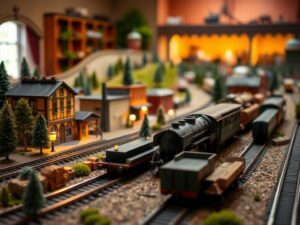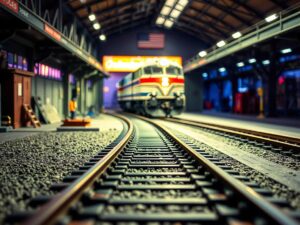How to Choose Realistic Scenery for Your HO Scale Layout
How to Choose Realistic Scenery for Your HO Scale Layout
How to Choose Realistic Scenery for Your HO Scale Layout
Welcome back, railfans! Today, we’re diving deep into a topic that brings life to our model railroad layouts: HO scale scenery selection.
There’s something truly magical about transforming your train layout from a simple track arrangement into a vibrant and believable miniature world. Realistic scenery is the key ingredient that elevates your HO scale masterpiece from “pretty” to “spectacular”. It draws the eye, tells a story, and immerses you deeper in the world you’ve built.
But where do you begin? The options are endless! Thatâs why weâre breaking down this process into manageable steps, offering tips and tricks for both beginners just starting their HO scale journey and seasoned enthusiasts looking to refine their landscape artistry.
Understanding Scale: Your Blueprint for Realism
Let’s start with the foundation – HO scale. 1:87 is the magic number here, meaning everything on your layout (trains, buildings, trees) represents something proportionally smaller in real life. While that sounds simple, it directly influences every element of scenery you choose.
Remember, details are king!
For example:
* Trees: Tiny trees might look good on a large-scale layout but become almost invisible on HO scale. You’ll want to carefully consider their size and density to avoid an overcrowded or sparsely populated forest.
* Buildings: Similarly, don’t be tempted to use oversized prefabricated houses meant for larger scales. Choose miniature architectural models that fit your chosen environment (urban, suburban, rural).
* Road Surfaces: Asphalted roads can feel blocky at HO scale, so using techniques like texturing or layering paints to create finer details is essential. Think gravel roads, cracked pavements, and crosswalks â the tiny details make a big difference!
Creating Depth and Dimension: The Layers of Your Landscape
Think of your HO scale scenery as a multi-layered cake. To add visual interest and realism, you need to think about different layers:
- The Base: This is your foundational layer, starting with the ground itself. Consider using a foam board base for easier sculpting or a plywood sheet if you prefer traditional construction methods. Texture it by applying various materials like cork board or Woodland Scenicsâ Foam Sheets for natural variations.
- The Undergrowth: Introduce foliage with bushes and small trees before moving to larger vegetation.
Use static grasses, flocks, or miniature trees (remembering the importance of scale!). This layer adds visual depth and sets the scene for your landscape’s character. -
The Water Features:
Add life to your layout by incorporating realistic water features. Still ponds with mirrored surfaces, flowing streams using resin materials, and even miniature waterfalls (using cascading water techniques) can transform your layout from ordinary to extraordinary. Remember that proper water effects rely heavily on detail work, but the payoff is well worth it!
- Structures: Your town buildings, farmhouses, or industrial structures form a key element of your HO scale world. Pay attention to placement, ensuring they create a harmonious cityscape and tell a compelling story within your chosen setting.
Letâs Talk Textures: Adding Substance to Your Scenes
Adding realistic texture is what elevates a collection of static elements into a living world. You can achieve this by experimenting with various materials:
-
Terrain Materials:
Woodland Scenics produces a fantastic range of textured dirt, sand, gravel, and clay mixtures that offer unparalleled realism when sculpted into hillsides, road beds, and riverbeds. Experiment with layering these to create dynamic, multi-dimensional terrain features. -
Foliage Techniques: There are many techniques to add realistic foliage. Static grasses are available in a range of shades and heights, while flocks (loose fiber imitations of plant life) offer an excellent way to add density and texture. Consider layering them for more realistic vegetation growth.
- Painting Effects: Use weathering paints, dry brushing, and wash techniques to create aging effects on structures, vehicles, and terrain elements. This adds a touch of authenticity and prevents your model world from looking brand new.
HO Scale Scenery Selection: Ideas to Ignite Your Creativity
Now let’s get creative! Think about the kind of story you want your layout to tell. Is it a bustling metropolis? A sleepy rural village?
-
Urban Sprawl:
Think skyscrapers, towering office blocks, intricate road networks with busy traffic. Consider incorporating miniature figures and detailed street scenes to capture the urban hustle and bustle.
Use weathering techniques and contrasting color palettes to emphasize grime and activity. -
Rural Retreat: Lush pastures, quaint farmsteads with barns and silos, meandering dirt roads – these evoke a tranquil atmosphere. Experiment with static grasses in varying shades of green, rolling hills created from foam board or plaster cloth, and perhaps even miniature livestock for added charm.
-
Industrial Powerhouse:
Factory buildings, bustling docks with cargo ships, smokestacks spewing out grey wisps â an industrial setting requires bold lines and grimy realism. Utilize metallic paints, weathering powders, and distressed textures to bring your factories and rail yards to life.
Remember, there’s no limit to what you can create! Let your imagination run wild, embrace the creative process, and donât be afraid to experiment.
The Journey is the Destination
One of the most important things to remember about HO scale scenery selection (or any hobby for that matter) is that itâs a journey, not a destination. Take your time, learn from others, and embrace mistakes as learning opportunities. Don’t hesitate to experiment with different materials and techniques, share your projects online with fellow model railroad enthusiasts, and most importantly, have fun!
Happy building, folks! Let’s keep those rails running and imaginations soaring.




